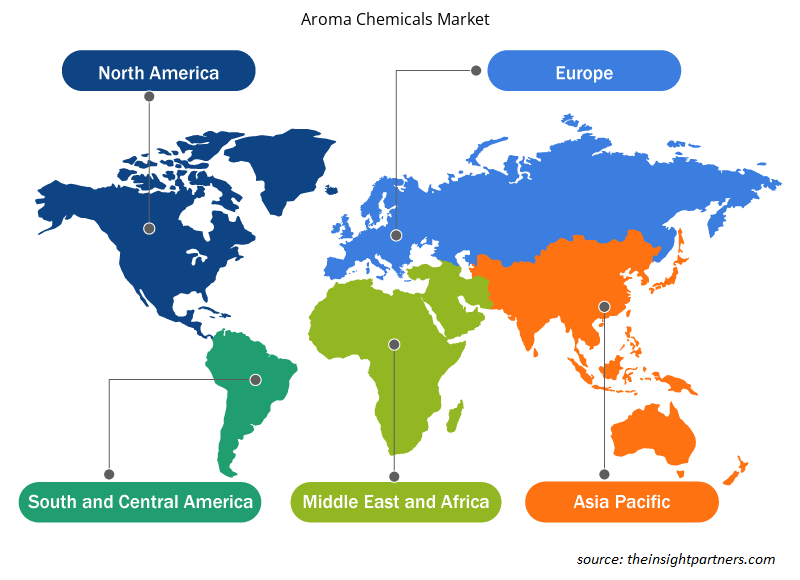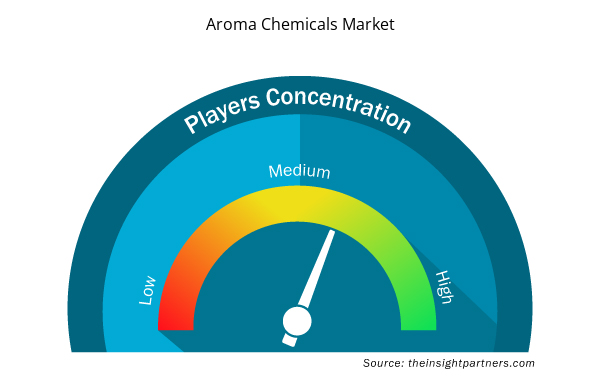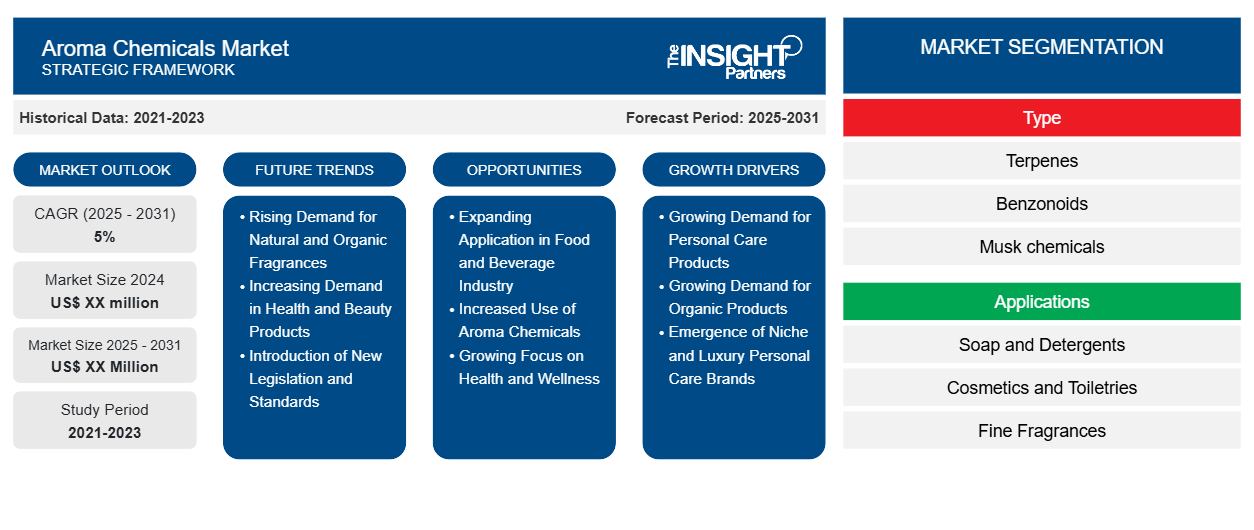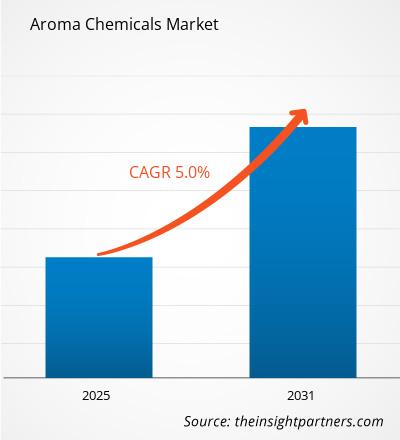Si prevede che il mercato dei prodotti chimici aromatici registrerà un CAGR del 5% dal 2024 al 2031, con una dimensione di mercato in espansione da XX milioni di dollari nel 2024 a XX milioni di dollari entro il 2031.
Il report è segmentato per tipo (terpeni, benzonoidi, sostanze chimiche del muschio e altri). Il report presenta inoltre analisi basate su applicazioni (saponi e detersivi, cosmetici e articoli da toeletta, profumi raffinati, prodotti per la casa, alimenti e bevande e altri). L'analisi globale è ulteriormente suddivisa a livello regionale e nei principali paesi. Il report offre il valore in USD per l'analisi e i segmenti di cui sopra.
Scopo del rapporto
Il report Aroma Chemicals Market di The Insight Partners mira a descrivere il panorama attuale e la crescita futura, i principali fattori trainanti, le sfide e le opportunità. Ciò fornirà spunti a vari stakeholder aziendali, come:
- Fornitori/produttori di tecnologia: per comprendere le dinamiche di mercato in evoluzione e conoscere le potenziali opportunità di crescita, consentendo loro di prendere decisioni strategiche informate.
- Investitori: condurre un'analisi completa delle tendenze in merito al tasso di crescita del mercato, alle proiezioni finanziarie del mercato e alle opportunità esistenti lungo la catena del valore.
- Enti di regolamentazione: regolamentano le politiche e le attività di controllo sul mercato allo scopo di ridurre al minimo gli abusi, preservare la fiducia degli investitori e sostenere l'integrità e la stabilità del mercato.
Segmentazione del mercato dei prodotti chimici aromatici
Tipo
- Terpeni
- Benzonoidi
- Prodotti chimici del muschio
- Altri
Applicazioni
- Saponi e Detersivi
- Cosmetici e articoli da toeletta
- Profumi raffinati
- Prodotti per la casa
- Cibo e bevande
- Altri
Personalizza questo report in base alle tue esigenze
Riceverai la personalizzazione gratuita di qualsiasi report, comprese parti di questo report, o analisi a livello nazionale, pacchetto dati Excel, oltre a usufruire di grandi offerte e sconti per start-up e università
- Scopri le principali tendenze di mercato in questo rapporto.Questo campione GRATUITO includerà analisi di dati che spaziano dalle tendenze di mercato alle stime e alle previsioni.
Fattori trainanti della crescita del mercato dei prodotti chimici aromatici
- Domanda crescente di prodotti per la cura della persona: la domanda crescente di prodotti per la cura della persona tra i consumatori ha un effetto molto positivo sul mercato dei prodotti chimici per l'aromaterapia. Man mano che le persone sviluppano un appetito per prodotti che le aiutano ad apparire belle e a sentirsi meglio, ci sarà un aumento nell'uso di profumi in creme, balsami e persino saponi. La necessità è quella di modificare il modo in cui i prodotti per la cura della persona vengono realizzati in diversi marchi.
- Domanda crescente di prodotti biologici: c'è un cambiamento anche nel mercato dei prodotti chimici per aromi, dove i consumatori cercano prodotti biologici naturali. I consumatori sono più esperti di ingredienti; cercano prodotti che siano gradevoli all'olfatto ma realizzati con oli essenziali ed estratti. Questo cambiamento li rende più aggressivi e attivi nella ricerca e nella produzione di prodotti chimici per aromi che soddisfino questa esigenza, incoraggiando quindi nuovi sviluppi.
- Emersione di marchi di nicchia e di lusso per la cura della persona: inoltre, l'emergere di marchi di nicchia e di lusso per la cura della persona sta portando a una maggiore necessità di fragranze più intricate ed esclusive. Tali marchi tendono a concentrarsi sull'offerta di prodotti con fragranze uniche, il che si traduce nell'uso di più tipi di sostanze chimiche aromatiche per la creazione di fragranze esclusive. Con l'aumento della domanda di odori e profumi diversi, anche la cifra per il mercato delle sostanze chimiche aromatiche crescerà.
Tendenze future del mercato dei prodotti chimici aromatici
- Domanda crescente di fragranze naturali e biologiche: la fiorente tendenza all'uso di profumi naturali e biologici sta influenzando anche le tendenze del mercato delle sostanze chimiche per aromi. Le preoccupazioni per la salute e l'ambiente stanno spingendo i consumatori a cercare prodotti più naturali. Ciò sta incoraggiando i produttori a usare e realizzare sostanze chimiche per aromi di origine vegetale per ampliare la loro base di mercato.
- Domanda crescente di prodotti per la salute e la bellezza: le fragranze naturali sono considerate prodotti autentici, per questo la loro domanda è in aumento nelle applicazioni per la salute e la bellezza e per la casa. Le aziende stanno a loro volta riqualificando i prodotti esistenti in modo da includere più sostanze chimiche aromatiche naturali nei loro prodotti per soddisfare i consumatori. Questo cambiamento aiuta a mantenere i clienti esistenti e ad aumentare la base di clienti.
- Introduzione di nuove normative e standard: la domanda del mercato sta cambiando a seguito dell'introduzione di nuove normative e standard che incoraggiano la produzione di prodotti più naturali e biologici. Poiché i governi e altre agenzie incoraggiano l'uso di una provenienza chiara degli ingredienti, si prevede che ci sarà una domanda crescente di fragranze naturali che hanno una certificazione approvata. Questa è una buona cosa per le aziende che si occupano di sostanze chimiche aromatiche sostenibili poiché saranno necessarie più innovazioni nello sviluppo di nuove formulazioni.
Opportunità di mercato per i prodotti chimici aromatici
- Espansione delle applicazioni nel settore alimentare e delle bevande: Dawn of Food and Beverage Applications sta creando un enorme potenziale di crescita per il mercato dei prodotti chimici aromatici. Con la crescente ricerca di gusti più raffinati ed elaborati da parte dei consumatori, è aumentata la domanda di prodotti chimici aromatici naturali e sintetici nei prodotti alimentari. Inoltre, questa tendenza fa ben sperare per lo sviluppo di nuove idee per agenti aromatizzanti che cercano di rendere i prodotti più accattivanti e aumentare il loro potenziale di mercato.
- Maggiore utilizzo di sostanze chimiche aromatiche: le sostanze chimiche aromatiche vengono aggiunte più frequentemente dai produttori per conferire un sapore unico ai prodotti, creando così un vantaggio competitivo. Questa tendenza è più pronunciata nei casi di snack, bevande e cucine speciali, dove l'uso di determinati odori rende l'esperienza piacevole e completa. Le aziende investono in sostanze chimiche aromatiche per rendere i loro prodotti più accattivanti di fronte alla crescente concorrenza.
- Crescente attenzione alla salute e al benessere: anche le tendenze della salute e del benessere stanno giocando la loro parte, nel mercato interessato, in particolare nel settore alimentare e delle bevande. Pertanto, questi consumatori optano per prodotti che hanno ciò che i produttori chiamano etichette pulite, che non contengono additivi chimici, il che a sua volta ha portato all'uso di alcuni prodotti chimici per aromi naturali che includono tali aspetti. Questa trasformazione apre nuovi mercati per i fornitori di aromi e sapori naturali, consentendo un'ulteriore espansione del mercato.flavours and aromas suppliers, enabling the market expansion further.
Approfondimenti regionali sul mercato dei prodotti chimici aromatici
Le tendenze regionali e i fattori che influenzano il mercato dei prodotti chimici per aromi durante il periodo di previsione sono stati ampiamente spiegati dagli analisti di Insight Partners. Questa sezione discute anche i segmenti e la geografia del mercato dei prodotti chimici per aromi in Nord America, Europa, Asia Pacifico, Medio Oriente e Africa e America centrale e meridionale.

- Ottieni i dati specifici regionali per il mercato dei prodotti chimici aromatici
Ambito del rapporto di mercato sui prodotti chimici aromatici
| Attributo del report | Dettagli |
|---|---|
| Dimensioni del mercato nel 2024 | XX milioni di dollari USA |
| Dimensioni del mercato entro il 2031 | XX milioni di dollari USA |
| CAGR globale (2025 - 2031) | 5% |
| Dati storici | 2021-2023 |
| Periodo di previsione | 2025-2031 |
| Segmenti coperti | Per tipo
|
| Regioni e Paesi coperti | America del Nord
|
| Leader di mercato e profili aziendali chiave |
|
Densità dei player del mercato dei prodotti chimici aromatici: comprendere il suo impatto sulle dinamiche aziendali
Il mercato dei prodotti chimici per aromi sta crescendo rapidamente, spinto dalla crescente domanda degli utenti finali dovuta a fattori quali l'evoluzione delle preferenze dei consumatori, i progressi tecnologici e una maggiore consapevolezza dei benefici del prodotto. Con l'aumento della domanda, le aziende stanno ampliando le loro offerte, innovando per soddisfare le esigenze dei consumatori e capitalizzando sulle tendenze emergenti, il che alimenta ulteriormente la crescita del mercato.
La densità degli operatori di mercato si riferisce alla distribuzione di aziende o società che operano in un particolare mercato o settore. Indica quanti concorrenti (operatori di mercato) sono presenti in un dato spazio di mercato in relazione alle sue dimensioni o al valore di mercato totale.
Le principali aziende che operano nel mercato dei prodotti chimici aromatici sono:
- Società Basf
- Firmenich SA.
- Frutarom Industries Ltd.
- Marchio Givaudan
- Aromi e fragranze internazionali Inc.
Disclaimer : le aziende elencate sopra non sono classificate secondo un ordine particolare.

- Ottieni una panoramica dei principali attori del mercato dei prodotti chimici aromatici
Punti di forza chiave
- Copertura completa: il rapporto esamina in modo completo i prodotti, i servizi, le tipologie e gli utenti finali del mercato dei prodotti chimici aromatici, offrendo una panoramica olistica.
- Analisi degli esperti: il rapporto è compilato sulla base della conoscenza approfondita di esperti e analisti del settore.
- Informazioni aggiornate: il rapporto garantisce la pertinenza aziendale grazie alla copertura di informazioni recenti e tendenze nei dati.
- Opzioni di personalizzazione: questo report può essere personalizzato per soddisfare le esigenze specifiche del cliente e adattarsi in modo appropriato alle strategie aziendali.
Il rapporto di ricerca sul mercato dei prodotti chimici per aromi può, quindi, aiutare a guidare il percorso di decodificazione e comprensione dello scenario del settore e delle prospettive di crescita. Sebbene possano esserci alcune preoccupazioni valide, i vantaggi complessivi di questo rapporto tendono a superare gli svantaggi.
- Analisi storica (2 anni), anno base, previsione (7 anni) con CAGR
- Analisi PEST e SWOT
- Valore/volume delle dimensioni del mercato - Globale, regionale, nazionale
- Industria e panorama competitivo
- Set di dati Excel



Report Coverage
Revenue forecast, Company Analysis, Industry landscape, Growth factors, and Trends

Segment Covered
This text is related
to segments covered.

Regional Scope
North America, Europe, Asia Pacific, Middle East & Africa, South & Central America

Country Scope
This text is related
to country scope.
Domande frequenti
#Rising Demand for Natural and Organic Fragrances is expected to be the key market trends.
Based on geography, Asia Pacific held the largest share of the aroma chemicals market.
BASF SE, Firmenich SA., Frutarom Industries Ltd. are some of the key players operating in the aroma chemicals market
Based on type, benzonoids is expected to witness the fastest growth during the forecast period
Growing Demand from personal Care Products is driving the market growth
The Aroma Chemicals Market is estimated to witness a CAGR of 5% from 2023 to 2031
Trends and growth analysis reports related to Chemicals and Materials : READ MORE..
1.Basf Corporation
2.Firmenich SA.
3.Frutarom Industries Ltd.
4.Givaudan
5.International Flavors and Fragrances Inc.
6.Kao Corporation
7.Robertet Group
8.Solvay Gmbh.
9.Symrise Ag.
10.Takasago International Corporation
The Insight Partners performs research in 4 major stages: Data Collection & Secondary Research, Primary Research, Data Analysis and Data Triangulation & Final Review.
- Data Collection and Secondary Research:
As a market research and consulting firm operating from a decade, we have published and advised several client across the globe. First step for any study will start with an assessment of currently available data and insights from existing reports. Further, historical and current market information is collected from Investor Presentations, Annual Reports, SEC Filings, etc., and other information related to company’s performance and market positioning are gathered from Paid Databases (Factiva, Hoovers, and Reuters) and various other publications available in public domain.
Several associations trade associates, technical forums, institutes, societies and organization are accessed to gain technical as well as market related insights through their publications such as research papers, blogs and press releases related to the studies are referred to get cues about the market. Further, white papers, journals, magazines, and other news articles published in last 3 years are scrutinized and analyzed to understand the current market trends.
- Primary Research:
The primarily interview analysis comprise of data obtained from industry participants interview and answers to survey questions gathered by in-house primary team.
For primary research, interviews are conducted with industry experts/CEOs/Marketing Managers/VPs/Subject Matter Experts from both demand and supply side to get a 360-degree view of the market. The primary team conducts several interviews based on the complexity of the markets to understand the various market trends and dynamics which makes research more credible and precise.
A typical research interview fulfils the following functions:
- Provides first-hand information on the market size, market trends, growth trends, competitive landscape, and outlook
- Validates and strengthens in-house secondary research findings
- Develops the analysis team’s expertise and market understanding
Primary research involves email interactions and telephone interviews for each market, category, segment, and sub-segment across geographies. The participants who typically take part in such a process include, but are not limited to:
- Industry participants: VPs, business development managers, market intelligence managers and national sales managers
- Outside experts: Valuation experts, research analysts and key opinion leaders specializing in the electronics and semiconductor industry.
Below is the breakup of our primary respondents by company, designation, and region:

Once we receive the confirmation from primary research sources or primary respondents, we finalize the base year market estimation and forecast the data as per the macroeconomic and microeconomic factors assessed during data collection.
- Data Analysis:
Once data is validated through both secondary as well as primary respondents, we finalize the market estimations by hypothesis formulation and factor analysis at regional and country level.
- Macro-Economic Factor Analysis:
We analyse macroeconomic indicators such the gross domestic product (GDP), increase in the demand for goods and services across industries, technological advancement, regional economic growth, governmental policies, the influence of COVID-19, PEST analysis, and other aspects. This analysis aids in setting benchmarks for various nations/regions and approximating market splits. Additionally, the general trend of the aforementioned components aid in determining the market's development possibilities.
- Country Level Data:
Various factors that are especially aligned to the country are taken into account to determine the market size for a certain area and country, including the presence of vendors, such as headquarters and offices, the country's GDP, demand patterns, and industry growth. To comprehend the market dynamics for the nation, a number of growth variables, inhibitors, application areas, and current market trends are researched. The aforementioned elements aid in determining the country's overall market's growth potential.
- Company Profile:
The “Table of Contents” is formulated by listing and analyzing more than 25 - 30 companies operating in the market ecosystem across geographies. However, we profile only 10 companies as a standard practice in our syndicate reports. These 10 companies comprise leading, emerging, and regional players. Nonetheless, our analysis is not restricted to the 10 listed companies, we also analyze other companies present in the market to develop a holistic view and understand the prevailing trends. The “Company Profiles” section in the report covers key facts, business description, products & services, financial information, SWOT analysis, and key developments. The financial information presented is extracted from the annual reports and official documents of the publicly listed companies. Upon collecting the information for the sections of respective companies, we verify them via various primary sources and then compile the data in respective company profiles. The company level information helps us in deriving the base number as well as in forecasting the market size.
- Developing Base Number:
Aggregation of sales statistics (2020-2022) and macro-economic factor, and other secondary and primary research insights are utilized to arrive at base number and related market shares for 2022. The data gaps are identified in this step and relevant market data is analyzed, collected from paid primary interviews or databases. On finalizing the base year market size, forecasts are developed on the basis of macro-economic, industry and market growth factors and company level analysis.
- Data Triangulation and Final Review:
The market findings and base year market size calculations are validated from supply as well as demand side. Demand side validations are based on macro-economic factor analysis and benchmarks for respective regions and countries. In case of supply side validations, revenues of major companies are estimated (in case not available) based on industry benchmark, approximate number of employees, product portfolio, and primary interviews revenues are gathered. Further revenue from target product/service segment is assessed to avoid overshooting of market statistics. In case of heavy deviations between supply and demand side values, all thes steps are repeated to achieve synchronization.
We follow an iterative model, wherein we share our research findings with Subject Matter Experts (SME’s) and Key Opinion Leaders (KOLs) until consensus view of the market is not formulated – this model negates any drastic deviation in the opinions of experts. Only validated and universally acceptable research findings are quoted in our reports.
We have important check points that we use to validate our research findings – which we call – data triangulation, where we validate the information, we generate from secondary sources with primary interviews and then we re-validate with our internal data bases and Subject matter experts. This comprehensive model enables us to deliver high quality, reliable data in shortest possible time.


 Ottieni un campione gratuito per questo repot
Ottieni un campione gratuito per questo repot